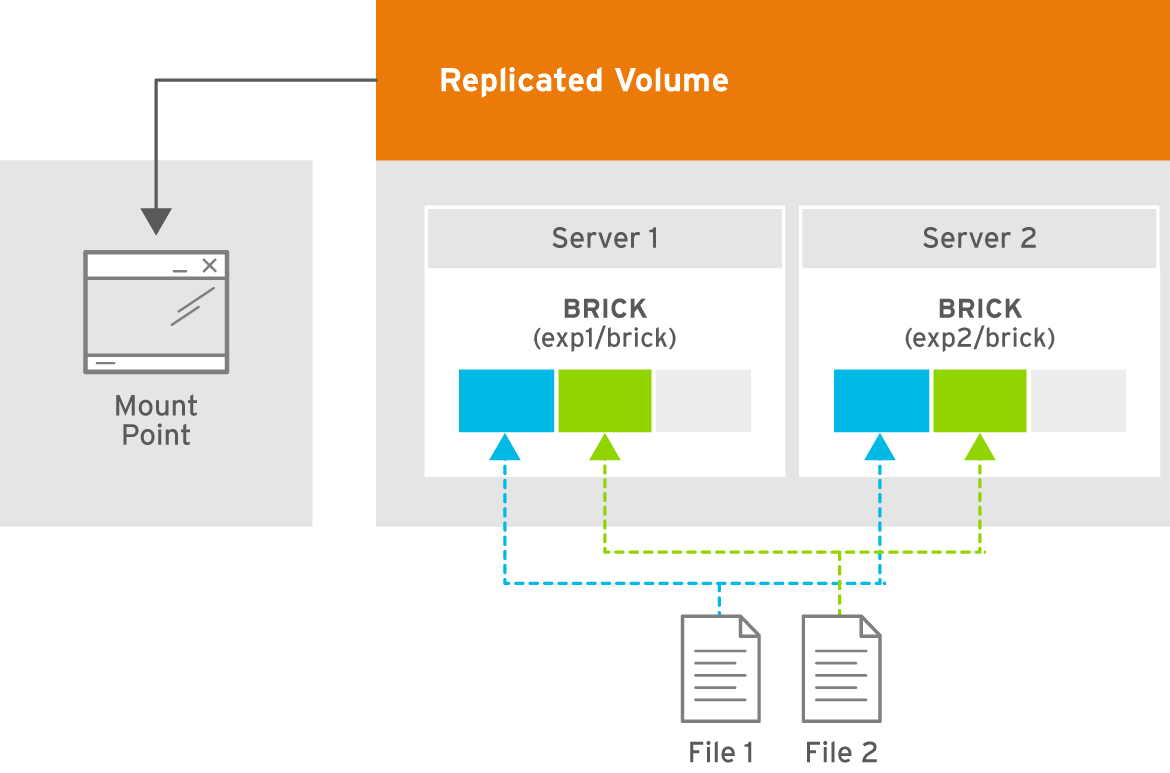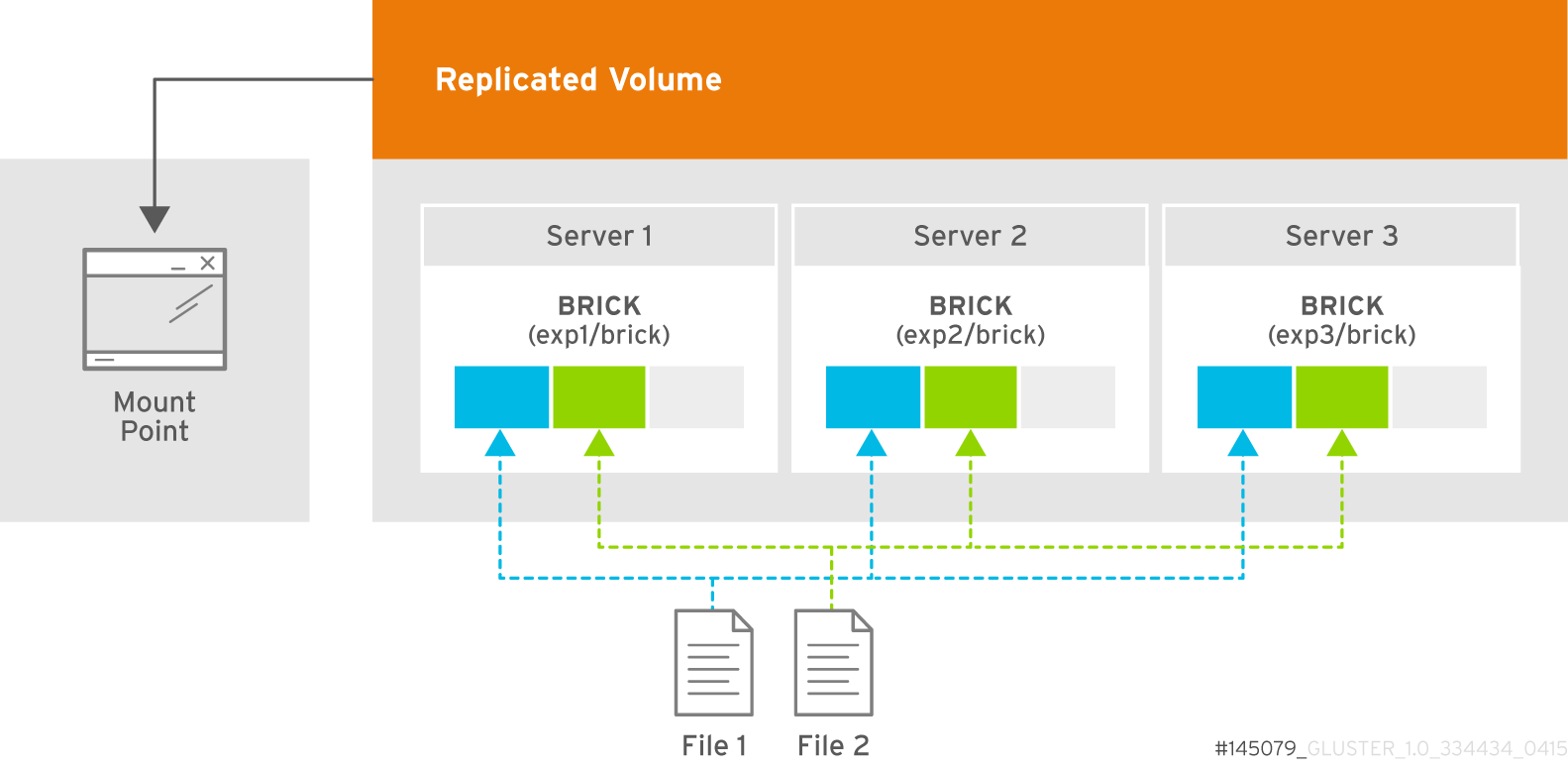6.6. Creating Replicated Volumes
Important
Creating replicated volume with replica count greater than 3 is under technology preview. Technology Preview features are not fully supported under Red Hat service-level agreements (SLAs), may not be functionally complete, and are not intended for production use.
Tech Preview features provide early access to upcoming product innovations, enabling customers to test functionality and provide feedback during the development process.
As Red Hat considers making future iterations of Technology Preview features generally available, we will provide commercially reasonable efforts to resolve any reported issues that customers experience when using these features.
Replicated volume creates copies of files across multiple bricks in the volume. Use replicated volumes in environments where high-availability and high-reliability are critical.
Use
gluster volume create to create different types of volumes, and gluster volume info to verify successful volume creation.
Prerequisites
- A trusted storage pool has been created, as described in Section 5.1, “Adding Servers to the Trusted Storage Pool”.
- Understand how to start and stop volumes, as described in Section 6.10, “Starting Volumes”.
6.6.1. Creating Two-way Replicated Volumes
Two-way replicated volume creates two copies of files across the bricks in the volume. The number of bricks must be multiple of two for a replicated volume. To protect against server and disk failures, it is recommended that the bricks of the volume are from different servers.

Figure 6.3. Illustration of a Two-way Replicated Volume
Creating two-way replicated volumes
- Run the
gluster volume createcommand to create the replicated volume.The syntax is# gluster volume create NEW-VOLNAME [replica COUNT] [transport tcp | rdma | tcp,rdma] NEW-BRICK...The default value for transport istcp. Other options can be passed such asauth.alloworauth.reject. See Section 10.1, “Configuring Volume Options” for a full list of parameters.Example 6.3. Replicated Volume with Two Storage Servers
The order in which bricks are specified determines how they are replicated with each other. For example, every2bricks, where2is the replica count, forms a replica set. This is illustrated in Figure 6.2. Illustration of a Two-way Replicated Volume.# gluster volume create test-volume replica 2 transport tcp server1:/exp1/brick server2:/exp2/brick Creation of test-volume has been successful Please start the volume to access data.
- Run
# gluster volume start VOLNAMEto start the volume.# gluster volume start test-volume Starting test-volume has been successful
- Run
gluster volume infocommand to optionally display the volume information.
Important
You must set client-side quorum on replicated volumes to prevent split-brain scenarios. For more information on setting client-side quorum, see Section 10.11.1.2, “Configuring Client-Side Quorum”
6.6.2. Creating Three-way Replicated Volumes
Three-way replicated volume creates three copies of files across multiple bricks in the volume. The number of bricks must be equal to the replica count for a replicated volume. To protect against server and disk failures, it is recommended that the bricks of the volume are from different servers.
Synchronous three-way replication is now fully supported in Red Hat Gluster Storage. Three-way replication volumes are supported only on JBOD configuration.

Figure 6.4. Illustration of a Three-way Replicated Volume
Creating three-way replicated volumes
- Run the
gluster volume createcommand to create the replicated volume.The syntax is# gluster volume create NEW-VOLNAME [replica COUNT] [transport tcp | rdma | tcp,rdma] NEW-BRICK...The default value for transport istcp. Other options can be passed such asauth.alloworauth.reject. See Section 10.1, “Configuring Volume Options” for a full list of parameters.Example 6.4. Replicated Volume with Three Storage Servers
The order in which bricks are specified determines how bricks are replicated with each other. For example, everynbricks, wherenis the replica count forms a replica set. This is illustrated in Figure 6.3. Illustration of a Three-way Replicated Volume.# gluster volume create test-volume replica 3 transport tcp server1:/exp1/brick server2:/exp2/brick server3:/exp3/brick Creation of test-volume has been successful Please start the volume to access data.
- Run
# gluster volume start VOLNAMEto start the volume.# gluster volume start test-volume Starting test-volume has been successful
- Run
gluster volume infocommand to optionally display the volume information.
Important
By default, the client-side quorum is enabled on three-way replicated volumes to minimize split-brain scenarios. For more information on client-side quorum, see Section 10.11.1.2, “Configuring Client-Side Quorum”